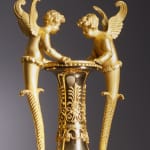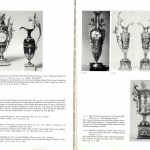
Hans Ottomeyer and Peter Pröschel, “Vergoldete Bronzen”, 1986, p. 364, pl. 5.12.6 illustrating a pair of ewers with similarly styled winged female rather than putti herm handles by Claude Galle and p. 365, pls. 5.12.9, 5.12.10 and 5.12.11, respectively illustrating a pair of ewers, a vase-shaped clock and an urn (the latter two in Stockholm Castle) by Galle, all of which feature similar winged figures. And on the same page, pl. 5.12.12, illustrating a vase-shaped clock case by Galle with almost identical bearded male masks, in the Grand Palais Versailles.

Arcadi Gaydamak, “Russian Empire, Architecture, Decorative and Applied Arts, Interior Decoration 1800-1830”, 2000, p. 237, illustrating a Russian silver gilt ewer in the State History Museum, Moscow that was inspired by the work of Claude Galle.
Claude Galle (attributed to)
Further images
Provenance
From a French private collection.
Literature
Hans Ottomeyer and Peter Pröschel, “Vergoldete Bronzen”, 1986, p. 364, pl. 5.12.6 illustrating a pair of ewers with similarly styled winged female rather than putti herm handles by Claude Galle and p. 365, pls. 5.12.9, 5.12.10 and 5.12.11, respectively illustrating a pair of ewers, a vase-shaped clock and an urn (the latter two in Stockholm Castle) by Galle, all of which feature similar winged figures. And on the same page, pl. 5.12.12, illustrating a vase-shaped clock case by Galle with almost identical bearded male masks, in the Grand Palais Versailles.
Arcadi Gaydamak, “Russian Empire, Architecture, Decorative and Applied Arts, Interior Decoration 1800-1830”, 2000, p. 237, illustrating a Russian silver gilt ewer in the State History Museum, Moscow that was inspired by the work of Claude Galle.
An extremely fine pair of Empire gilt bronze vases “aux amours” attributed to Claude Galle, each of elongated baluster form with a pair of handles formed as two winged putti who rest their hands on the circular gadrooned rim of the vase, mounted below around its neck with scrolled anthemion, the putti-shaped handles arising from tapering acanthus leaves supported upon the back of a crouching winged griffin that are each seated upon the head of a bearded Bacchic head, with an anthemion band around the body of the vase and a fluted base above a spreading circular foot that rests upon a shaped plinth, each side of which is mounted with alternate winged putto supporting a scrolled anthemion and a torchère surmounted by a griffin
Paris, date circa 1805-10
Height 54 cm. each.
This outstanding and unusually large ewer can be attributed to Claude Galle (1759-1815), one of the foremost bronziers and fondeur-ciseleurs of the late Louis XVI and Empire periods, whose oeuvre included a number of similar vases, ewers and clock cases featuring comparable winged figures either surmounting or forming part of the handle. Likewise, Galle featured the same bearded Bacchic male mask heads within his repertoire. The model incorporating an ovoid body on a splayed circular foot and surmounted by winged herm handles proved to be an enduringly popular model, especially for ewers (which unlike vases had only one handle), examples of which can be found a pair at Pavlovsk Palace near St. Petersburg (illustrated in “Pavlovsk: Le Palais et le Parc, Les Collections”, 1993, vol. I, p. 121) and another in the Mobilier National (illustrated in Marie-France Dupuy-Baylet, “L’Heure, le Feu, la Lumière: Les Bronzes du Mobilier National 1800-1870”, 2010, pp. 248-9).
A leader in his field, Claude Galle was born at Villepreux near Versailles and then travelled to Paris to begin an apprenticeship under the fondeur, Pierre Foy. In 1784 Galle married Foy’s daughter and on his father-in-law's death in 1788 Galle took over the workshop, which he built up into one the finest of its kind with a workforce of about 400 craftsmen. Galle promptly moved the business to Quai de la Monnaie (renamed Quai de 1’Unité) and from 1805 operated from 60 Rue Vivienne. First listed in the trade registers in 1784 he was received as a maître-fondeur in 1786 and promptly gained the first of many commissions from the Garde-Meuble de la Couronne under Jean Hauré from 1786-88. He is known to have collaborated with Pierre-Philippe Thomire, amongst others, and was responsible for the majority of bronzes d’ameublement supplied during the Empire to Château de Fontainebleau. Other Imperial commissions included the supply of numerous vases, ewers, light fittings, figural clock cases and other fine bronze furnishings for the palaces at Saint-Cloud, the Trianons, Tuileries, Compiègne, Rambouillet and a number of the Italian palaces including Monte Cavallo, Rome and Stupinigi near Turin. Yet despite numerous important commissions Galle was often in debt, partly on account of his lavish life style and also since many of his clients, such as Prince Joseph Napoleon, failed to pay him. After his death Galle’s business was reopened and prospered under his son, Gérard-Jean Galle (1788-1846). His work can be found among the world’s finest collections including those mentioned above as well as the Musée National de Château de Malmaison, the Musée Marmottan in Paris, the Museo de Relojes at Jerez de la Frontera, the Residenz Munich and the Victoria and Albert Museum in London.





